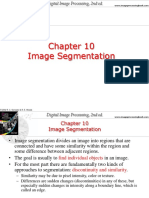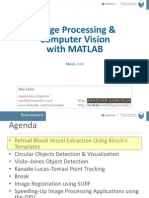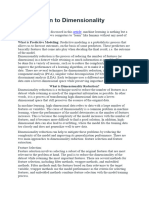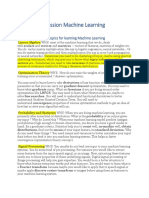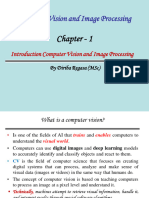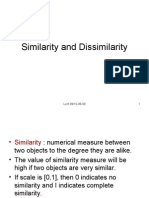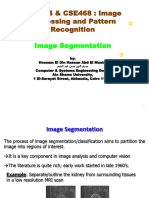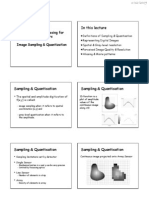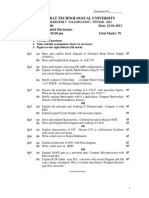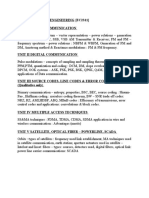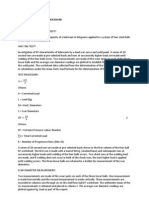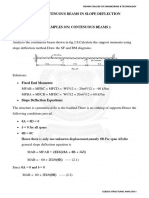1
of
19
Digital Image Processing
Image EnhancementSpatial Filtering
From:
Digital Image Processing, Chapter 3
Refael C. Gonzalez & Richard E. Woods
�2
of
19
Contents
Next, we will look at spatial filtering
techniques:
What is spatial filtering?
Smoothing Spatial filters.
Sharpening Spatial Filters.
Combining Spatial Enhancement Methods
�3
of
19
Neighbourhood Operations
Neighbourhood operations simply operate
on a larger neighbourhood of pixels than
point operations
Origin
Neighbourhoods are
mostly a rectangle
around a central pixel
Neighbourhood
Any size rectangle
and any shape filter
are possible
y
Image f (x, y)
(x, y)
�4
of
19
Neighbourhood Operations
For each pixel in the origin image, the
outcome is written on the same location at
the target image.
Origin
Origin
Neighbourhood
(x, y)
Image f (x, y)
Target
�5
of
19
Simple Neighbourhood Operations
Simple neighbourhood operations example:
Min: Set the pixel value to the minimum in
the neighbourhood
Max: Set the pixel value to the maximum in
the neighbourhood
�6
of
19
The Spatial Filtering Process
Origin
Simple 3*3
Neighbourhood
3*3 Filter
Image f (x, y)
Original Image
Pixels
Filter (w)
eprocessed = n*e +
j*a + k*b + l*c +
m*d + o*f +
p*g + q*h + r*i
The above is repeated for every pixel in the
original image to generate the filtered image
�Images taken from Gonzalez & Woods, Digital Image Processing (2002)
7
of
19
Spatial Filtering: Equation Form
g ( x, y )
w(s, t ) f ( x s, y t )
s at b
Filtering can be given
in equation form as
shown above
Notations are based
on the image shown
to the left
�8
of
19
Smoothing Spatial Filters
One of the simplest spatial filtering
operations we can perform is a smoothing
operation
Simply average all of the pixels in a
neighbourhood around a central value
Especially useful
1
1
1
/9
/9
/9
in removing noise
Simple
from images
1
1
1
/9
/9
/9 averaging
Also useful for
filter
highlighting gross
1
1
1
/9
/9
/9
detail
�9
of
19
Smoothing Spatial Filtering
Origin
104 100 108
99 106 98
95
Simple 3*3
Neighbourhood
1
1
1
/9 100
/9 108
/9
104
1
/9 106
/9 198
/9
99
/9 190
/9 185
/9
95
90
85
Original Image
3*3 Smoothing
Pixels
/9
/9
/9
/9
/9
/9
/9
/9
/9
Filter
Filter
Image f (x, y)
e = 1/9*106 +
1
/9*104 + 1/9*100 + 1/9*108 +
1
/9*99 + 1/9*98 +
1
/9*95 + 1/9*90 + 1/9*85
= 98.3333
The above is repeated for every pixel in the
original image to generate the smoothed image
�Images taken from Gonzalez & Woods, Digital Image Processing (2002)
10
of
19
Image Smoothing Example
The image at the top left
is an original image of
size 500*500 pixels
The subsequent images
show the image after
filtering with an averaging
filter of increasing sizes
3, 5, 9, 15 and 35
Notice how detail begins
to disappear
�Images taken from Gonzalez & Woods, Digital Image Processing (2002)
11
of
19
Image Smoothing Example
�Images taken from Gonzalez & Woods, Digital Image Processing (2002)
12
of
19
Image Smoothing Example
�Images taken from Gonzalez & Woods, Digital Image Processing (2002)
13
of
19
Image Smoothing Example
�Images taken from Gonzalez & Woods, Digital Image Processing (2002)
14
of
19
Image Smoothing Example
�Images taken from Gonzalez & Woods, Digital Image Processing (2002)
15
of
19
Image Smoothing Example
�Images taken from Gonzalez & Woods, Digital Image Processing (2002)
16
of
19
Image Smoothing Example
�17
of
19
Weighted Smoothing Filters
More effective smoothing filters can be
generated by allowing different pixels in the
neighbourhood different weights in the
averaging function
Pixels closer to the
central pixel are more
important
Often referred to as a
weighted averaging
/16
/16
/16
/16
/16
/16
/16
/16
/16
Weighted
averaging filter
�Images taken from Gonzalez & Woods, Digital Image Processing (2002)
18
of
19
Another Smoothing Example
By smoothing the original image we get rid
of lots of the finer detail which leaves only
the gross features for thresholding
Original Image
Smoothed Image
* Image taken from Hubble Space Telescope
Thresholded Image
�Images taken from Gonzalez & Woods, Digital Image Processing (2002)
19
of
19
Averaging Filter Vs. Median Filter
Example
Original Image
With Noise
Image After
Averaging Filter
Image After
Median Filter
Filtering is often used to remove noise from
images
Sometimes a median filter works better than
an averaging filter
�Images taken from Gonzalez & Woods, Digital Image Processing (2002)
20
of
19
Averaging Filter Vs. Median Filter
Example
Original
�Images taken from Gonzalez & Woods, Digital Image Processing (2002)
21
of
19
Averaging Filter Vs. Median Filter
Example
Averaging
Filter
�Images taken from Gonzalez & Woods, Digital Image Processing (2002)
22
of
19
Averaging Filter Vs. Median Filter
Example
Median
Filter
�23
of
19
Strange Things Happen At The Edges!
At the edges of an image we are missing
pixels to form a neighbourhood
Origin
e
e
Image f (x, y)
�24
of
19
Strange Things Happen At The Edges!
(cont)
There are a few approaches to dealing with
missing edge pixels:
Omit missing pixels
Only works with some filters
Can add extra code and slow down processing
Pad the image
Typically with either all white or all black pixels
Replicate border pixels
Truncate the image
�25
of
19
Correlation & Convolution
The filtering we have been talking about so
far is referred to as correlation with the filter
itself referred to as the correlation kernel
Convolution is a similar operation, with just
one subtle difference
a
Original Image
Pixels
Filter
eprocessed = v*e +
z*a + y*b + x*c +
w*d + u*e +
t*f + s*g + r*h
For symmetric filters it makes no difference
�26
of
19
Sharpening Spatial Filters
Previously we have looked at smoothing
filters which remove fine detail
Sharpening spatial filters seek to highlight
fine detail
Remove blurring from images
Highlight edges
Sharpening filters are based on spatial
differentiation
�Images taken from Gonzalez & Woods, Digital Image Processing (2002)
27
of
19
Spatial Differentiation
Differentiation measures the rate of change of
a function
Lets consider a simple 1 dimensional
example
�Images taken from Gonzalez & Woods, Digital Image Processing (2002)
28
of
19
Spatial Differentiation
A
B
�29
of
19
1st Derivative
The formula for the 1st derivative of a
function is as follows:
f
f ( x 1) f ( x)
x
Its just the difference between subsequent
values and measures the rate of change of
the function
�30
of
19
1st Derivative (cont)
f(x)
5 5 4 3 2 1 0 0 0 6 0 0 0 0 1 3 1 0 0 0 0 7 7 7 7
0 -1 -1 -1 -1 0 0 6 -6 0 0 0 1 2 -2 -1 0 0 0 7 0 0 0
f(x)
�31
of
19
2nd Derivative
The formula for the 2nd derivative of a
function is as follows:
f
f ( x 1) f ( x 1) 2 f ( x)
2
x
2
Simply takes into account the values both
before and after the current value
�32
of
19
2nd Derivative (cont)
f(x)
5 5 4 3 2 1 0 0 0 6 0 0 0 0 1 3 1 0 0 0 0 7 7 7 7
-1 0 0 0 0 1 0 6
f(x)
-12
6 0 0 1 1 -4 1 1 0 0 7 -7 0 0
�33
of
19
f(x)
f(x)
f(x)
1st and 2nd Derivative
�34
of
19
Using Second Derivatives For Image
Enhancement
The 2nd derivative is more useful for image
enhancement than the 1st derivative
Stronger response to fine detail
Simpler implementation
We will come back to the 1st order derivative
later on
The first sharpening filter we will look at is
the Laplacian
Isotropic
One of the simplest sharpening filters
We will look at a digital implementation
�35
of
19
The Laplacian
The Laplacian is defined as follows:
f f
f 2 2
x y
where the partial 1st order derivative in the x
direction is defined as follows:
2
f
f ( x 1, y ) f ( x 1, y ) 2 f ( x, y )
2
x
and in the y direction as follows:
2
f
f ( x, y 1) f ( x, y 1) 2 f ( x, y )
2
y
2
�36
of
19
The Laplacian (cont)
So, the Laplacian can be given as follows:
f [ f ( x 1, y ) f ( x 1, y )
f ( x, y 1) f ( x, y 1)]
4 f ( x, y )
2
We can easily build a filter based on this
0
-4
�Images taken from Gonzalez & Woods, Digital Image Processing (2002)
37
of
19
The Laplacian (cont)
Applying the Laplacian to an image we get a
new image that highlights edges and other
discontinuities
Original
Image
Laplacian
Filtered Image
Laplacian
Filtered Image
Scaled for Display
�Images taken from Gonzalez & Woods, Digital Image Processing (2002)
38
of
19
But That Is Not Very Enhanced!
The result of a Laplacian filtering
is not an enhanced image
We have to do more work in
order to get our final image
Subtract the Laplacian result
from the original image to
generate our final sharpened
enhanced image
g ( x, y ) f ( x, y ) f
2
Laplacian
Filtered Image
Scaled for Display
�Images taken from Gonzalez & Woods, Digital Image Processing (2002)
39
of
19
Laplacian Image Enhancement
Original
Image
=
Laplacian
Filtered Image
Sharpened
Image
In the final sharpened image edges and fine
detail are much more obvious
�Images taken from Gonzalez & Woods, Digital Image Processing (2002)
40
of
19
Laplacian Image Enhancement
�41
of
19
Simplified Image Enhancement
The entire enhancement can be combined
into a single filtering operation
g ( x, y ) f ( x, y ) f
f ( x, y ) [ f ( x 1, y ) f ( x 1, y )
f ( x, y 1) f ( x, y 1)
4 f ( x, y )]
5 f ( x, y ) f ( x 1, y ) f ( x 1, y )
f ( x, y 1) f ( x, y 1)
2
�Images taken from Gonzalez & Woods, Digital Image Processing (2002)
42
of
19
Simplified Image Enhancement (cont)
This gives us a new filter which does the
whole job for us in one step
0
-1
-1
-1
-1
�Images taken from Gonzalez & Woods, Digital Image Processing (2002)
43
of
19
Simplified Image Enhancement (cont)
�Images taken from Gonzalez & Woods, Digital Image Processing (2002)
44
of
19
Variants On The Simple Laplacian
There are lots of slightly different versions of
the Laplacian that can be used:
0
-4
Simple
Laplacian
-8
-1
-1
-1
-1
-1
-1
-1
-1
Variant of
Laplacian
�45
of
19
Unsharp Mask & Highboost Filtering
Using sequence of linear spatial filters in
order to get Sharpening effect.
-Blur
- Subtract from original image
- add resulting mask to original image
�46
of
19
Highboost Filtering
�47
of
19
1st Derivative Filtering
Implementing 1st derivative filters is difficult in
practice
For a function f(x, y) the gradient of f at
coordinates (x, y) is given as the column
vector:
f
Gx x
f
f
Gy
�48
of
19
1st Derivative Filtering (cont)
The magnitude of this vector is given by:
f mag (f )
G G
2
x
2
y
f
f
x
y
2
For practical reasons this can be simplified as:
f G x G y
�49
of
19
1st Derivative Filtering (cont)
There is some debate as to how best to
calculate these gradients but we will use:
f z7 2 z8 z9 z1 2 z 2 z3
z3 2 z6 z9 z1 2 z 4 z7
which is based on these coordinates
z1
z2
z3
z4
z5
z6
z7
z8
z9
�50
of
19
Sobel Operators
Based on the previous equations we can
derive the Sobel Operators
-1
-2
-1
-1
-2
-1
To filter an image it is filtered using both
operators the results of which are added
together
�Images taken from Gonzalez & Woods, Digital Image Processing (2002)
51
of
19
Sobel Example
An image of a
contact lens which
is enhanced in
order to make
defects (at four
and five oclock in
the image) more
obvious
Sobel filters are typically used for edge
detection
�52
of
19
1st & 2nd Derivatives
Comparing the 1st and 2nd derivatives we
can conclude the following:
1st order derivatives generally produce thicker
edges
2nd order derivatives have a stronger
response to fine detail e.g. thin lines
1st order derivatives have stronger response
to grey level step
2nd order derivatives produce a double
response at step changes in grey level
�Images taken from Gonzalez & Woods, Digital Image Processing (2002)
53
of
19
Combining Spatial Enhancement
Methods
Successful image
enhancement is typically
not achieved using a single
operation
Rather we combine a range
of techniques in order to
achieve a final result
This example will focus on
enhancing the bone scan to
the right
�Combining Spatial Enhancement
Methods (cont)
Images taken from Gonzalez & Woods, Digital Image Processing (2002)
54
of
19
(a)
Laplacian filter
bone scan (a)
of
(b)
Sharpened version of
bone scan achieved
(c)
by subtracting (a)
Sobel filter of bone
and (b)
scan (a)
(d)
�Images taken from Gonzalez & Woods, Digital Image Processing (2002)
55
of
19
Combining Spatial Enhancement
Methods (cont)
The product of (c)
and (e) which will be
used as a mask
(e)
Result of applying a
power-law trans. to
Sharpened image (g)
which is sum of (a)
(g)
and (f)
Image (d) smoothed with
a 5*5 averaging filter
(f)
(h)
�Images taken from Gonzalez & Woods, Digital Image Processing (2002)
56
of
19
Combining Spatial Enhancement
Methods (cont)
Compare the original and final images

